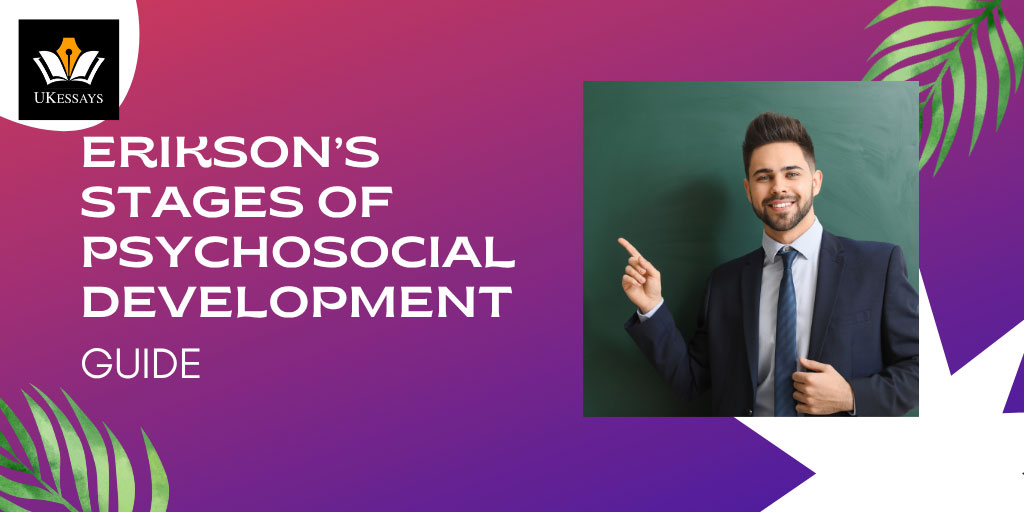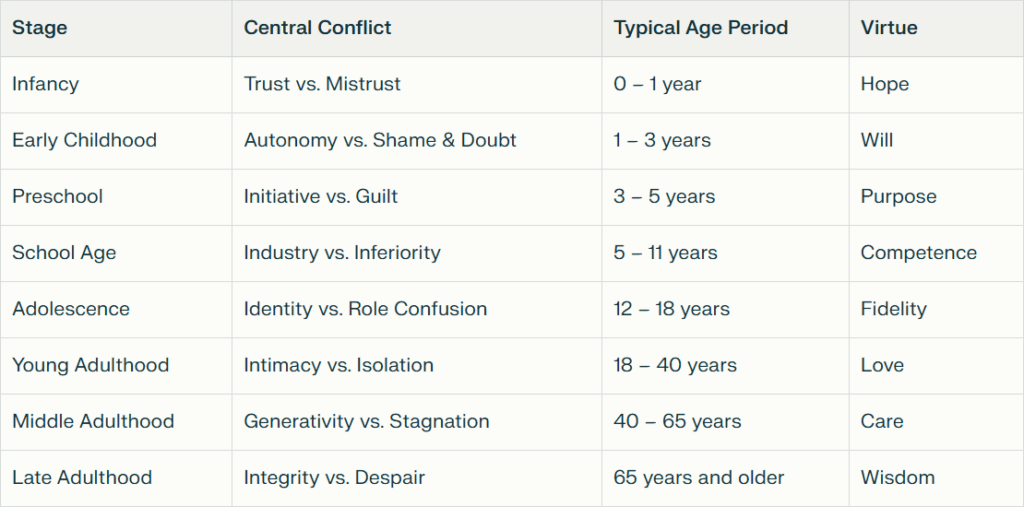Erikson’s stages of psychosocial development guide
Info: 3279 words (13 pages) Study Guides
Published: 01 Oct 2025

Struggling to apply Erikson’s stages in your essay? Get help from a UK-qualified expert now. See our psychology assignment help page for more info.
Erik Erikson (1902–1994) was a psychoanalytic psychologist who proposed a theory of psychosocial development covering the entire lifespan (Erikson 1950).
His model describes eight sequential stages. Each stage has a core conflict, or “psychosocial crisis,” that individuals must resolve for healthy personality growth (Erikson 1950; Erikson 1968).
Unlike Freud’s earlier psychosexual theory focused only on childhood, Erikson’s approach emphasised social relationships and cultural context, extending development into adulthood and old age. Successful resolution of each stage’s conflict results in the acquisition of a psychological strength or virtue that bolsters subsequent development (Erikson 1950).
In contrast, failure to resolve a crisis can predispose the individual to difficulties in later stages. However, later experiences may help to compensate for earlier deficiencies to some extent (McLeod 2025).
Figure: Overview of Erikson’s eight psychosocial stages, showing each stage’s central conflict, the typical age period, and the positive virtue gained when resolved.
Erikson’s theory rests on an epigenetic principle, suggesting that development unfolds in a predetermined sequence of stages influenced by biological maturation and social context (Erikson 1950). Each stage builds on the outcomes of previous ones.The challenges of later stages cannot be met successfully without sufficiently resolving earlier crises.
However, Erikson maintained that no conflict is ever completely resolved. People continue to grow and revisit earlier themes in new contexts throughout life (Erikson 1982). Optimal development involves finding a dynamic balance between the opposing tendencies. For example, a healthy personality emerges from predominantly trusting early relationships, tempered by a touch of realistic mistrust – rather than either extreme alone.

Stage 1: trust versus mistrust
The first psychosocial stage, trust versus mistrust, spans roughly from birth to 1 year of age and corresponds to infancy (Erikson 1950). In this period, an infant is utterly dependent on caregivers to meet basic needs such as nourishment, comfort and affection.
The central question is whether the infant can trust the world and people to provide care and consistency. If caregivers are responsive – reliably providing food, warmth and affection – the infant learns that caregivers will be dependable. This fosters a fundamental sense of trust in the environment (Erikson 1950).
Consistent, loving care leads the child to view the world as safe and predictable. This forms the basis of a secure attachment.
Conversely, if care is inconsistent, neglectful or rejecting, the infant may develop mistrust, seeing the world as unpredictable or unsafe.
An infant who experiences prolonged hunger, discomfort or distress without reliable relief begins to feel insecure and wary of others. This pessimistic outlook can manifest as anxiety and suspicion.
Importantly, successful development in this stage is not about eliminating mistrust entirely, but about achieving a favorable balance. When caregivers usually meet the infant’s needs – yet occasional frustrations occur – the child acquires the virtue of hope. Hope is a basic optimism that even when life brings adversity, support will be available (Erikson 1968). A predominantly mistrustful infant, by contrast, may carry a sense of fear and insecurity into future relationships.
Stage 2: autonomy versus shame and doubt
The second stage, autonomy versus shame and doubt, occurs in early childhood (about ages 1 to 3 years). At this time, toddlers strive for increasing independence. At this age, children begin to walk, talk and assert their preferences. For example, a toddler may insist on deciding what to wear or attempt to feed themselves.
The central issue is the child’s growing need for autonomy and self-control. If caregivers encourage the toddler’s attempts at self-sufficiency (within safe limits), the child develops a sense of autonomy. They begin to feel capable of acting on the world and exercising personal choice (Orenstein & Lewis 2020).
A supportive parent will allow the child to try things (such as toilet training or dressing) and learn from mistakes. The parent intervenes gently as needed but does not overreact to accidents or mess.
By contrast, overly critical or controlling caregiving can undermine the child’s confidence. If a child’s efforts at independence are met with harsh criticism, frequent correction or overprotection, the child may start to feel ashamed of their failures. They can begin to doubt their own abilities.
Erikson emphasised that finding a balance is key. Children need reasonable limits and guidance, but they also require the freedom to attempt tasks on their own (Erikson 1950). When parents support a child’s autonomy more often than not, children emerge from this stage with the virtue of will. Will is the determination to act independently and with self-control. Excessive shame and doubt, in contrast, can lead to low self-esteem and a tendency to rely on others.
Stage 3: initiative versus guilt
The third stage, initiative versus guilt, corresponds to the preschool years (about ages 3 to 5). In this period, the child’s world expands as they engage in imaginative play and interact with peers. Children also begin to assert power over their environment.
The primary challenge is for the child to develop initiative – a sense of ambition and responsibility, and the confidence to initiate activities. Children who have opportunities to plan games, ask questions and carry out their own ideas (with appropriate guidance) learn to take initiative. They come to view themselves as leaders and decision-makers who can make things happen. Caregivers and teachers can foster initiative by encouraging creativity and offering praise for effort and good ideas.
If, however, a child’s initiatives are met with criticism or excessive control, the child may develop guilt about their desires and efforts. For example, a child who is constantly criticised for making a mess or being “too bossy” during play may start to feel bad about trying to lead or create. They could become hesitant and self-critical, fearing that their attempts to assert themselves are wrong.
Striking a healthy balance between initiative and restraint leads to the virtue of purpose. Purpose is the courage to envision and pursue valued goals (Erikson 1968). A child with a strong sense of purpose feels able to take initiative while also cooperating with others. If guilt dominates, the child may become overly inhibited or afraid to act on their impulses. Such inhibition can potentially stifle creativity and leadership in later life.
Stage 4: industry versus inferiority
The fourth stage, industry versus inferiority, spans approximately the early school-age years (around 5 to 11 years old). At this stage, children enter the wider social context of school and begin to compare their abilities with peers. The developmental task is to cultivate a sense of industry – diligence, skill and competence in useful tasks.
Through schoolwork, hobbies and friendships, children learn to work towards goals and to derive pride from accomplishments. Children are more likely to develop a strong sense of industry when parents and teachers encourage them to persist in solving problems and provide praise for their efforts. They start to believe in their ability to learn new skills and to contribute meaningfully. This applies in academics, sports or other activities (Erikson 1982).
If a child encounters excessive criticism or repeated failure without support, feelings of inferiority may take hold. Children who feel they do not measure up to their peers – academically, socially or athletically – can lose confidence in their own competence. For example, lack of encouragement from parents and teachers can cause children to doubt their abilities. If authority figures convey to a child that they are “not good enough”, the child may begin to doubt their abilities.
Erikson noted that some failure can be instructive, teaching humility and persistence. However, a child must experience success often enough to believe in their own capabilities (Erikson 1950). Achieving a positive balance in this stage yields the virtue of competence – a confident belief in one’s ability to master tasks and challenges. If inferiority prevails, the result may be poor self-confidence and reluctance to attempt new things. This mindset can potentially hinder learning and development.
Stage 5: identity versus role confusion
The fifth stage, identity versus role confusion, occurs during adolescence (approximately ages 12 to 18). In this stage, the individual faces the crucial task of forging a personal identity. Erikson defined identity as a coherent sense of self that includes one’s values, goals and place in society. Adolescents grapple with questions like “Who am I?” and “What do I want to become?” (Erikson 1968). This often involves exploring different roles, beliefs and lifestyles. For example, a teenager might experiment with different friend groups, interests or styles of dress to discover what fits their emerging identity. Adolescents are more likely to settle on an authentic identity if they have support and room for exploration from family and community. Successfully resolving the identity crisis leads to a stable sense of self and continuity. Erikson termed this outcome identity achievement (Marcia 1966).
If adolescents are unable to establish a clear identity, they experience role confusion – an unstable sense of who they are. This confusion can manifest as aimlessness, insecurity or a shifting self-image. Role confusion can arise from various factors. These include a lack of opportunities for exploration, inconsistent feedback from others or pressure to conform to roles that do not feel genuine. For instance, an adolescent forced to pursue a career path they do not want may feel alienated from their true self.
Erikson believed that identity formation is the cornerstone of a healthy personality. It provides the foundation for adulthood (Erikson 1968). A positive resolution of this stage yields the virtue of fidelity. Fidelity means loyalty and the ability to live true to oneself while also accepting others’ differences. Modern research suggests that identity development often extends into the twenties. Many young people continue exploring roles during the phase of “emerging adulthood” (Côté 2006). Nonetheless, adolescence is seen as the pivotal period for setting the groundwork of a unified identity.
Stage 6: intimacy versus isolation
The sixth stage, intimacy versus isolation, occurs in young adulthood (roughly ages 18 to 40, though timing can vary). With an identity established at least in part, the young adult’s focus turns to building close intimate relationships with others. Intimacy in Erikson’s sense refers not only to sexual or romantic bonds but also to deep friendships and emotional connections. The challenge is to fuse one’s identity with that of another person without losing oneself. Essentially, the goal is to achieve a mutual commitment and love. A secure sense of self makes it easier to risk the vulnerability required for intimacy. Such individuals can reach out to form lasting partnerships based on trust, care and shared identity (Erikson 1982). Successful resolution of this stage is evident in strong relationships. For example, a solid marriage or a lifelong close friendship allows individuals to be open and empathetic.
Failure to establish intimacy leads to isolation – feeling alienated, alone or unable to connect deeply with others. An individual who still lacks a secure identity may have trouble committing to relationships because they fear losing themselves. If a young adult cannot form affectionate ties – due to mistrust, self-centredness or other barriers – they risk becoming isolated and lonely. Erikson noted that some degree of solitude is healthy, but a persistent pattern of isolation can impede emotional growth. A positive outcome at this stage produces the virtue of love. Love is the capacity to form lasting, meaningful bonds that include compromise, devotion and care (Erikson 1982). By contrast, unresolved isolation can result in a sense of emptiness or interpersonal fear. This state may lead one to distance themselves from potential sources of support.
Stage 7: generativity versus stagnation
The seventh stage, generativity versus stagnation, corresponds to middle adulthood (approximately ages 40 to 65). Generativity broadly means nurturing and guiding the next generation and contributing to society. Stagnation, by contrast, implies a lack of growth or productivity.
At this stage, people typically seek to create or nurture things that will outlast themselves (Erikson 1982). This often involves raising children. It can also include mentoring younger people, engaging in meaningful work, pursuing creative projects or doing community service. A middle-aged adult high in generativity invests energy in helping others and in productive activities that give life a sense of purpose. For instance, they might serve as a mentor at work, volunteer in the community or work to build a family legacy. Through such efforts, individuals feel that they are contributing positively and that their lives matter beyond their own existence.
In contrast, stagnation involves self-absorption, complacency and a lack of psychological growth. An adult who does not feel they are contributing, or who lacks connection to community and younger generations, may stagnate. They often experience a sense of emptiness or a midlife crisis.
Finding a healthy balance in this stage leads to the virtue of care. Care represents a broad concern for others and for the future of society (Erikson 1982). A caring, generative person gains satisfaction from feeling needed and from making a difference in others’ lives. On the other hand, predominance of stagnation can result in feelings of futility and shallow involvement in the world. Erikson believed the strength developed through generativity is crucial for facing the final stage of life.
Stage 8: integrity versus despair
The eighth and final stage in Erikson’s original model is integrity versus despair, associated with late adulthood (around age 65 and beyond). As individuals enter old age, they typically reflect on their lives, evaluating their achievements and failures. The key psychosocial question in late adulthood is whether one can look back on life with a sense of integrity – meaning acceptance, fulfillment and wholeness. The alternative is falling into despair over missed opportunities and mistakes. An elder who has lived largely in line with their values and found meaning in their personal history is likely to attain ego integrity (Erikson 1982). This entails accepting one’s life as it was, acknowledging both successes and failures without excessive regret. Such acceptance gives rise to a sense of peace and wisdom. It allows the person to face aging and mortality with equanimity.
If an individual is dissatisfied with how life has turned out – due to unrealised goals or lingering guilt, for example – they may struggle with despair. Despair involves feeling that it is now too late to start over and that life has been mis-spent. This can bring about bitterness, regret or fear of death. Erikson observed that even well-adjusted people experience some regrets. However, those who can integrate their life experiences into a coherent narrative tend to avoid debilitating despair (Erikson 1982).
When integrity prevails, the virtue that emerges is wisdom. Wisdom is a mature insight into life’s complexities, accompanied by a sense of serenity. Wisdom enables older adults to advise younger generations. It also helps them accept the end of life as the natural culmination of their personal story. In his later years, Erik Erikson – together with his wife Joan – contemplated a possible ninth stage of development. In this stage, very elderly adults would revisit the earlier crises under the new conditions of extreme old age (Erikson & Erikson 1997). This later addition underscores that development may continue to evolve even in our final decades.
Critical perspectives on Erikson’s theory
Erikson’s psychosocial stage theory has been highly influential for its expansive view of human development. It also provides a positive framing of lifelong growth. It has generated widespread practical insights. Many people intuitively identify with the described stages and conflicts.
However, scholars have raised several criticisms and limitations of the theory (McLeod 2025). One critique is that Erikson’s model is primarily descriptive and lacks specificity about the mechanisms of development. The theory outlines what the key conflicts and ideal outcomes are. However, it does not clearly explain how individuals move successfully from one stage to the next, or what triggers the resolution of a crisis (Erikson 1964). For example, Erikson posited basic trust in infancy as crucial. However, he did not detail the precise experiences that foster trust versus mistrust beyond describing general caregiving quality. This vagueness makes the theory hard to test empirically and to apply in a predictive way.
Another challenge involves the rigidity of stages and ages. Erikson did assign approximate age ranges to each psychosocial stage, but real-life development varies widely. Some individuals might reach particular milestones earlier or later, depending on personal and familial factors. Researchers have questioned whether Erikson’s eight crises are truly universal across cultures (McLeod 2025). For example, some adults might revisit adolescent-style identity exploration when making career changes in midlife. Similarly, cultural context can shift the emphasis or timing of certain stages, meaning Erikson’s neat age-based sequence doesn’t necessarily apply to everyone.
Erikson developed his theory primarily from observations of Western, industrialised populations. As a result, it tends to emphasise individualist values (such as autonomy and personal identity). Anthropological and cross-cultural research indicates that concepts of self and social responsibility vary significantly, raising doubts about the universal application of Erikson’s model across different cultural contexts. These differences have led some to argue that the model contains a cultural bias. It may not fully capture development in non-Western or minority cultural contexts.
Additionally, gender perspectives have provided nuanced critiques. Erikson formulated his stage theory in an era of traditional gender roles. Some psychologists suggest that the sequence might not apply equally to all genders (Gilligan 1982). For instance, the notion that identity formation (Stage 5) must precede intimacy (Stage 6) remains debated. Some psychologists observe that women’s identity development can occur through relational contexts (Gilligan 1982). Such insights question whether Erikson’s male-centric sequencing is universally valid.
In response to such critiques, later researchers have extended and refined Erikson’s ideas rather than discarding them entirely. James Marcia, for example, built on Erikson’s concept of adolescent identity by operationalising identity statuses (such as identity achievement, moratorium, foreclosure, and diffusion). This approach allowed researchers to empirically study how youths navigate the identity stage (Marcia 1966). Other scholars introduced the concept of emerging adulthood to acknowledge that identity exploration often continues into the twenties (Côté 2006). These developments suggest that Erikson’s broad framework remains a valuable foundation. However, the details of psychosocial development can be more complex than a strict eight-stage progression.
However, modern psychology recognises that individual development may follow more varied pathways than the neatly defined stages. Cultural context, historical changes and personal circumstances all interact with the psychosocial tasks Erikson described. As with any stage theory, there is a tension between the simplicity that makes it broadly applicable and the diversity of human experiences that resist a one-size-fits-all model.
Struggling to apply Erikson’s stages in your essay? Get help from a UK-qualified expert now. See our psychology assignment help page for more info.
References and further reading:
- Côté, J. E. (2006) ‘Emerging adulthood as an institutionalized moratorium: Risks and benefits to identity formation’, in Arnett, J. J. and Tanner, J. L. (eds) Emerging adults in America: Coming of age in the 21st century. Washington, DC: American Psychological Association, pp. 85–116.
- Erikson, E. H. (1950) Childhood and Society. New York: W. W. Norton & Company.
- Erikson, E. H. (1964) Insight and Responsibility. New York: W. W. Norton & Company.
- Erikson, E. H. (1968) Identity: Youth and Crisis. New York: W. W. Norton & Company.
- Erikson, E. H. (1982) The Life Cycle Completed. New York: W. W. Norton & Company.
- Erikson, E. H. and Erikson, J. M. (1997) The Life Cycle Completed: Extended Version. New York: W. W. Norton & Company.
- Gilligan, C. (1982) In a Different Voice: Psychological Theory and Women’s Development. Cambridge, MA: Harvard University Press.
- Marcia, J. E. (1966) ‘Development and validation of ego-identity status’, Journal of Personality and Social Psychology, 3(5), pp. 551–558.
- McLeod, S. (2025) Erik Erikson’s stages of psychosocial development. SimplyPsychology. Available at: https://www.simplypsychology.org/erik-erikson.html (Accessed: 30 September 2025).
- Orenstein, G. A. and Lewis, L. (2020) ‘Erikson’s stages of psychosocial development’, in StatPearls [Internet]. Treasure Island, FL: StatPearls Publishing. Available at: https://www.ncbi.nlm.nih.gov/books/NBK556096/ (Accessed: 1 October 2025).
Cite This Work
To export a reference to this article please select a referencing stye below:



